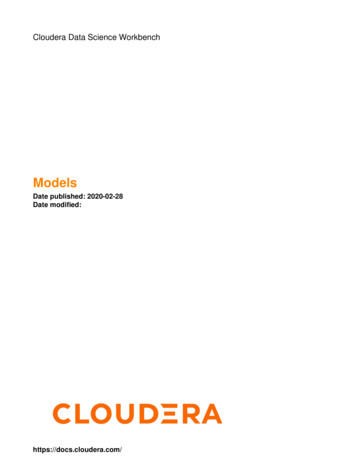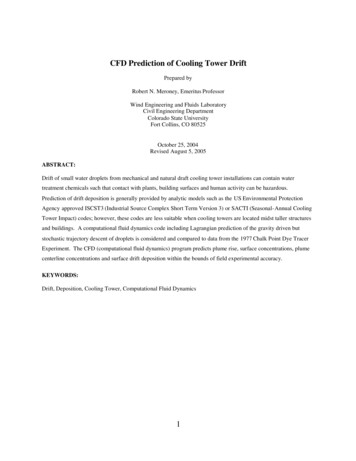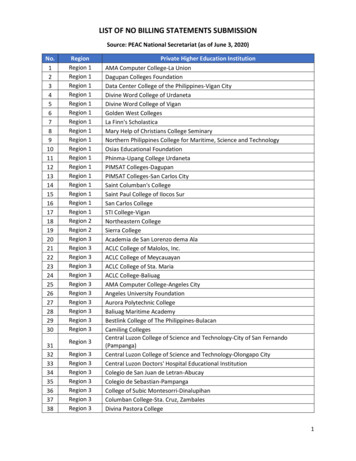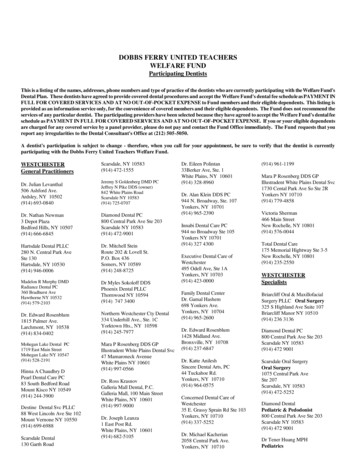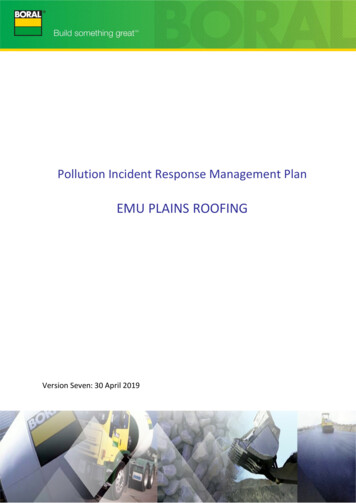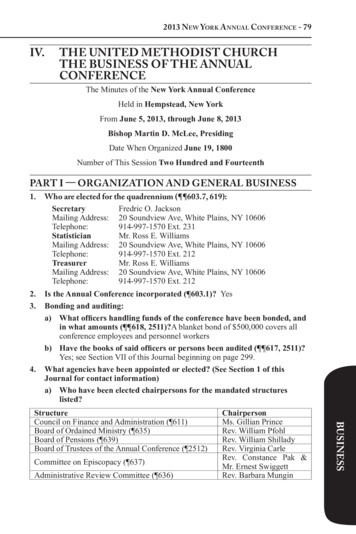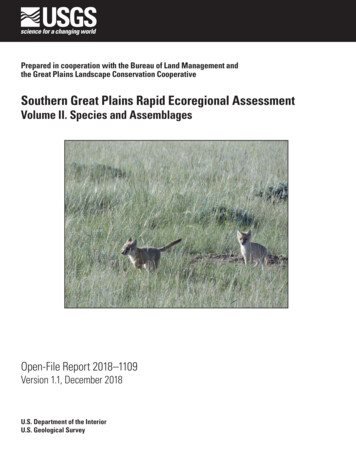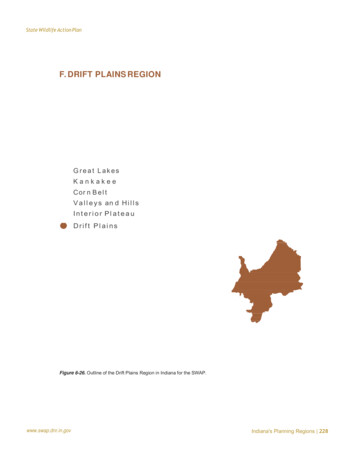
Transcription
State Wildlife Action PlanF. DRIFT PLAINS REGIONGreat LakesKankakeeCor n B e l tV a l l e y s an d H i l l sInt erior Pl atea uDrift PlainsFigure 6-26. Outline of the Drift Plains Region in Indiana for the SWAP.www.swap.dnr.in.govIndiana's Planning Regions 228
State Wildlife Action PlanIntroductionThis section summarizes habitat conditions, threats to SGCN and their habitats,and conservation actions for species and habitats in the Drift Plains Region. Thissection also reviews land cover changes over the past decade and identifies uniquehabitat types in this region. Summaries of threats to and conservation actions forSGCN and their habitats that were generated from two surveys can be found at theend of this section.In addition to the threats and actions identified in the Habitat Survey and theSpecies Survey, the DFW recognized the need to identify threats aligned withspecific actions. Several threats and actions were identified as ubiquitous across allsixregions. These include: Habitat Loss: Develop and promote farming technologies and practices that haveconservation benefits (e.g., cover crops, no-till, and soil health) Invasive Species: Build external capacity (form and facilitate partnerships, alliances,and networks of organizations to address invasive species) Law and Policy: Develop, change, influence and help implement formal legislation,regulations and voluntary standards Dams and Water Management and Use: Remove unnecessary dams and utilizenecessary dams with effective fish passage structuresThe DFW also identified specific threats and actions for each SWAP region based onDFW priorities. These threats were identified due to their high level of relevancy tothe specific region and the workability of the associated actions. These threats andactions for the Drift Plains Region include: Habitat Loss of Barren Lands and Glades: Build external capacity by formingpartnerships and networks, raising and providing funds and resources forconservation organizations to maintain and protect barren lands and glades Land management (e.g., timber cutting, fire, girdling, and mechanical andchemical treatments Habitat Loss of Wetlands: Build external capacity by forming partnerships andnetworks, raising and providing funds and resources for conservation organizationsto maintain and protect wetlandswww.swap.dnr.in.govIndiana's Planning Regions 229
State Wildlife Action PlanCurrent Habitat ConditionsDuring the Species Survey, respondents were asked to identify SGCN within theDrift Plains Region. A full summary of the Species Survey results can be found inAppendix O.Table 6-16. Species of Great Conservation Need present in the Drift Plains Region.TaxaScientific NameCommon NameAmphibiansNecturus maculosusCommon MudpuppyAmphibiansAmbystoma barbouriStreamside SalamanderAmphibiansHemidactylium scutatumFour-toed SalamanderAmphibiansAcris blanchardiBlanchard's Cricket FrogAmphibiansLithobates areolatusCrawfish FrogBirdsCygnus buccinatorTrumpeter SwanBirdsColinus virginianusNorthern BobwhiteBirdsBonasa umbellusRuffed GrouseBirdsChordeiles minorCommon NighthawkBirdsAntrostomus vociferusEastern Whip-poor-willBirdsRallus elegansKing RailBirdsGallinula galeataCommon GallinuleBirdsGrus canadensisSandhill CraneBirdsGrus americanaWhooping CraneBirdsPluvialis dominicaAmerican Golden-ploverBirdsCharadrius melodusPiping PloverBirdsBartramia longicaudaUpland SandpiperBirdsArenaria interpresRuddy TurnstoneBirdsCalidris subruficollisBuff-breasted SandpiperBirdsLimnodromus griseusShort-billed DowitcherBirdsScolopax minorAmerican WoodcockBirdsTringa solitariaSolitary SandpiperBirdsTringa melanoleucaGreater YellowlegsBirdsPhalaropus tricolorWilson’s PhalaropeBirdsSternula antillarum athalassosInterior Least TernBirdsChlidonias nigerBlack TernBirdsBotaurus lentiginosusAmerican BitternBirdsIxobrychus exilisLeast BitternBirdsArdea albaGreat EgretBirdsNycticorax nycticoraxBlack-crowned Night-heronBirdsNyctanassa violaceaYellow-crowned Night-heronBirdsPandion haliaetusOspreyBirdsIctinia mississippiensisMississippi Kitewww.swap.dnr.in.govIndiana's Planning Regions 230
State Wildlife Action PlanTaxaScientific NameCommon NameBirdsHaliaeetus leucocephalusBald EagleBirdsCircus cyaneusNorthern HarrierBirdsAccipiter striatusSharp-shinned HawkBirdsButeo platypterusBroad-winged HawkBirdsTyto albaBarn OwlBirdsAsio flammeusShort-eared OwlBirdsFalco peregrinusPeregrine FalconBirdsLanius ludovicianusLoggerhead ShrikeBirdsCistothorus platensisSedge WrenBirdsCistothorus palustrisMarsh WrenBirdsAmmodramus henslowiiHenslow’s SparrowBirdsXanthocephalus xanthocephalusYellow-headed BlackbirdBirdsHelmitheros vermivorumWorm-eating WarblerBirdsVermivora chrysopteraGolden-winged WarblerBirdsMniotilta variaBlack-and-white WarblerBirdsSetophaga citrinaHooded WarblerBirdsSetophaga ceruleaCerulean WarblerFishAnguilla rostrataAmerican EelFishNoturus stigmosusNorthern MadtomFishEtheostoma variatumVariegate DarterFishPercina copelandiChannel DarterFishPercopsis omiscomaycusTrout-perchMammalsSorex hoyiAmerican Pygmy ShrewMammalsMyotis grisescensGray MyotisMammalsMyotis lucifugusLittle Brown MyotisMammalsMyotis septentrionalisNorthern Long-eared MyotisMammalsMyotis sodalisIndiana MyotisMammalsLasionycteris noctivagansSilver-haired BatMammalsPerimyotis subflavusTri-colored BatMammalsNycticeius humeralisEvening BatMammalsLasiurus borealisEastern Red BatMammalsLasiurus cinereusHoary BatMammalsCorynorhinus rafinesquiiRafinesque’s Big-eared BatMammalsUrsus americanusBlack BearMammalsMustela nivalisLeast WeaselMammalsTaxidea taxusAmerican BadgerMollusksPlethobasus cyphyusSheepnoseMollusksPleurobema cordatumOhio PigtoeMollusksPtychobranchus fasciolarisKidneyshellMollusksSimpsonaias ambiguaSalamander MusselMollusksToxolasma lividumPurple LilliputMollusksVillosa lienosaLittle Spectaclecasewww.swap.dnr.in.govIndiana's Planning Regions 231
State Wildlife Action PlanTaxaScientific NameCommon NameReptilesTerrapene carolinaEastern Box TurtleReptilesNerodia erythrogaster neglectaCopper-bellied WatersnakeReptilesClonophis kirtlandiiKirtland’s SnakeReptilesOpheodrys aestivusRough GreensnakeReptilesCemophora coccineaScarletsnakeReptilesTantilla coronataSoutheastern Crowned SnakeReptilesCrotalus horridusTimber RattlesnakeDuring the Habitat Survey, respondents were asked to evaluate the overall quality offish and wildlife habitats in the Drift Plains Region (Fig. 6-27), estimate changes inoverall quality since 2005 (Fig. 6-28), and predict changes in overall quality over thenext ten years (Fig. 6-29). Each respondent was asked to respond for one or more ofthe eight major habitat types within the region and results were aggregated at theregional level. A full list of the Habitat Survey results can be found in Appendix P.www.swap.dnr.in.govIndiana's Planning Regions 232
State Wildlife Action PlanAgricultural LandsAquatic SystemsBarren Lands16.7% 8.3%Developed LandsForestsSubterranean SystemsWetlandsGrasslands63.6%27.3%Very PoorSatisfactoryVery G o o dPoorGoodI Don’t KnowFigure 6-27. Overall quality of fish and wildlife habitats in the Drift Plains Region in 2014.www.swap.dnr.in.govIndiana's Planning Regions 233
State Wildlife Action PlanAgricultural LandsAquatic Systems60%OVERALL60.3%66.7%40%Developed LandsBarren LandsForests20%WetlandsSubterranean edth e s am eIncreasedI d o n ’ t kno wFigure 6-28. Estimated change in the overall quality of fish and wildlife habitats from 2005 to 2014 for each ofthe major habitat types in the Drift Plains Region.www.swap.dnr.in.govIndiana's Planning Regions 234
State Wildlife Action PlanAgricultural LandsAquatic Systems2.7%40%9.5%8.3%52.7%OVERALL25%60%Developed LandsForestsBarren Lands8%48%40%Subterranean %DecreasedRemainedth e s am eIncreasedI d o n ’ t kno wFigure 6-29. Predicted changes in overall quality of fish and wildlife habitats over the next ten years for eachmajor habitat type in the Drift Plains Region.www.swap.dnr.in.govIndiana's Planning Regions 235
State Wildlife Action PlanChanges in Land CoverUnlike other regions of the state, which are dominated by agricultural lands,most land cover in the Drift Plains Region consists of forested land, followed byagricultural lands and grasslands (Fig. 6-30). Compared to other Indiana regions,the Drift Plains Region has a relatively low percentage of developed lands. Theregion is also home to limited areas of Indiana’s karst subterranean systems.The Drift Plains Region has experienced changes in habitat coverage over the pastten years. Agricultural lands, aquatic systems, barren lands, developed lands, andwetlands increased while forests and grasslands decreased. These habitats weremostly lost to urban development (Fig. 6-30). Percentage-wise, the greatest netlosses were seen in grasslands (1.3%) and forests (0.6%). The greatest net increaseswere seen in wetlands (59.6%), barren lands (23.6%), and aquatic systems (4.4%).Comprising of only .03% of the total land cover in the region, these habitat typeswere not abundant to begin with.www.swap.dnr.in.govIndiana's Planning Regions 236
State Wildlife Action PlanAgricultural LandsAquatic SystemsBarren LandDeveloped 001,200,000AcresAgricultural LandsAquatic SystemsBarren LandDeveloped LandsForestGrasslandsWetlands-7,000 -5,000 -3,000 -1,000 1,000 3,0005,000 7,000AcresLossGainFigure 6-30. Distribution of land cover and losses and gains in land cover in the Drift Plains Region between2001 and 2011 from NLCD.www.swap.dnr.in.govIndiana's Planning Regions 237
State Wildlife Action PlanThreats Affecting HabitatsTop Threat CategoriesThe third element requires the description of threats to SGCN and their habitats.The SWAP identifies a habitat perspective in order to manage for the conservationof species in Indiana. This section utilizes the same hierarchical method ofidentifying and rating threats based on Salafsky et al. (2008) that was outlined inChapter V. Category rankings and specific threat rankings for habitats in thisregion are outlined below (Table 6-17). A full summary of the Habitat Survey resultsfor the Great Lakes Region can be found in Appendix P.For first-level threat categories, all threat categories were rated either significantto moderate or moderate to minor for the region. Agriculture and aquaculture wasidentified as a significant threat to habitats within this region. Within this category,conversion of habitat to annual crops and annual and perennial non-timber cropswere both, on average, rated as significant to moderate specific second-levelthreats.Residential and commercial development was ranked highly across different majorhabitat types; invasive and other problematic species and genes were also ratedhighly across categories. Invasive and alien species received a mean threat ratingbetween significant and moderate, while other specific threats in this categorywere rated in the moderate to minor threat level for this region.Categories ranked below invasive species received regional ratings of moderateminor threats. Human intrusion and disturbance was ranked as the most significantthreat category for barren lands, developed lands, and subterranean systems.Within barren lands and subterranean systems, recreational activities were rated asa significant to moderate threat. Natural system modification was rated as the topthreat in wetlands. Within this category, natural habitat conversion was rated as asignificant and moderate threat to wetlands.Within the pollution category, the most significant threats identified were runofffrom service corridors, agricultural and residential development, and forestryeffluents and point source pollution. Both diseases and low genetic diversity wererated as significant to moderate threats within other stressors, another mid-rankedthreat category to this region.Energy production and mining, climate change and other severe weather, andbiological resource use were on average rated closer to minor threats thanmoderate threats. However, within the climate change category, temperatureextremes, shifting seasons, and changing frequency/duration of droughts wererated as significant to moderate specific threats within the region. Forestry practiceswere also rated as a significant to moderate threat across all habitat types andrated especially high in barren lands, grasslands, and wetlands.www.swap.dnr.in.govIndiana's Planning Regions 238
State Wildlife Action PlanRegional RankingAquatic SystemsAgricultural LandsBarren LandsDeveloped LandsForestsGrasslandsSubterranean SystemsWetlandsTable 6-17. Threat category ranking to habitats in the Drift Plains Region. First-level threat categories are based onhierarchical method of identifying threats outlines in Salafsky et al. (2008). Ranked threat categories for the entireregion are arranged by each major habitat type (1 - highest threat).Agriculture and Aquaculture111383162Residential and Commercial Development233222333Invasive and Other Problematic Species and Genes322431427Human Intrusion and Disturbance484114216Natural Systems Modification546957671Pollution655566745Other Stressors7976105594Transportation and Service Corridors8797410959Energy Production and Mining9610891110118Climate Change and Severe Weather101081111911810Biological Resource na's Planning Regions 239
State Wildlife Action PlanTop Specific Threats in Ranked OrderIn the Habitat Survey, respondents were also asked to identify specific threats tomajor habitat types using the same threat category ranking system outlined inSalafsky et al. (2008). These second-level threats represent subcategories of threatswithin the major threat categories listed in the table above. The following are thetop specific second-level threats to habitats in the Drift Plains Region, aggregatedacross habitat types:1.2.3.4.5.6.7.8.9.Invasive and alien speciesConversion of habitat to annual cropsConversion of natural habitats to other land usesHousing and urban areasCommercial and industrial areasRecreation activitiesAnnual and perennial non-timber cropsPlant diseasesProblematic native species10. Livestock farming and ranchingIn the Species Survey, respondents were also asked to identify threats to individualSGCN using the same threat category ranking system. The following are the topspecific (second-level) threats to SGCN occurring in the Drift Plains Region,aggregated across all species:1.2.3.4.5.6.7.8.Natural habitat conversionInvasive and alien speciesHousing and urban areasConversion of habitat to annual cropsCommercial and industrial areasAnnual and perennial non-timber cropsTourism and recreation areasRecreation areas9.Livestock farming and ranchingEmerging/Anticipated ThreatsRespondents were asked specifically to identify any emerging or anticipatedthreats over the next ten years for fish and wildlife habitats within the majorhabitat types for a region in a free-response question.In this region, respondents identified an emerging threat was a growing disconnectto natural resources, which might increase difficulty in sustaining public support forlands devoted to conservation. Other respondents identified more land-basedthreats like fragmentation and forest pests, such as the emerald ash borer.www.swap.dnr.in.govIndiana's Planning Regions 240
State Wildlife Action PlanConservation Actions NeededTop Action CategoriesThe fourth element requires that the SWAP describe conservation actions proposedto conserve identified species and habitats as well as outlining priorities for theirimplementation. This section outlines conservation actions identified at theregional level for each of the major habitat types. This section follows the sameprotocol to rate and rank actions in this region based on Salafsky et al. (2008) thatwas outlined in Chapter V. A full list of survey results can be found in Appendix P.Category rankings for actions and specific actions are outlined in the list on thefollowing page (Table 6-18).Regionally, land, water, andspecies management, educationandawareness, landand water protection, and livelihood, economic, and other incentives receivedaverage category ratings between very and moderately important. Law and policyand external capacity building were rated between moderately and somewhatimportant. No action category ranked in the somewhat to not important range,indicating the identification of a wide range and variety of specific actions importantto conservation of habitats within the region.Within land, water, and species management, approximately half of the specificactions were on average rated as very to moderately important regionally. Topranking actions identified a need to restore natural systems, promote a diversityof successional stages, and control invasive species in a variety of habitat types.Reducing loss of habitat was also ranked as the most important action in agriculturallands, barren lands, and developed lands while being highly ranked in the remaininghabitat types. Species reintroduction was also identified as important in forests,grasslands, and wetlands, with respondents suggesting reintroduction of extirpatednative species, native grasses, quail and other game birds, crawfish frog, elk, blackbears, wolves, hellbenders, and threatened mussel species.Education and awareness also ranked highly for this region. Education programsin general, education programs for K-12, and training programs for stakeholders allreceived mean ratings between very and moderately important for this region.Land and water protection was ranked third regionally; every specific action exceptfor acquiring currently unprotected barren lands was rated between very andmoderately important. Important actions in this region reflects a need to acquireunprotected habitats and preserve currently existing corridors. Reducing conversionto cropland and strengthening CRP partnerships were also identified as the mostimportant actions in multiple habitat types.Livelihood, economic, and other incentives was ranked between very and moderatelyimportant as a category within this region. Promoting conservation payments wasranked firegionally and within every habitat type within this category. Promotingnonmonetary values of natural systems and managing recreational opportunitiesto be compatible with fish and wildlife habitats were also both rated as very tomoderately important specific actions within this category for this region.Within law and policy, respondents identified an importance for regulations oninvasive species and improving compliance and enforcement of current policies.Using zoning to reduce urban sprawl was ranked as the most important action forhabitats in aquatic systems and developed lands. Changing current policy wasrated between moderately to somewhat important, but respondents did suggestwww.swap.dnr.in.govIndiana's Planning Regions 241
State Wildlife Action Planpolicy changes to increase pollution control regulations, reducing turtle harvest,and wetland mitigation.Promotion of research in conservation decision-making, developing alliancesand partnerships, increasing state’s capacity for research and monitoring ofconservation actions, and strengthening conservation financing were all ratedbetween very and moderately important within external capacity building forthis region.Barren LandsDeveloped Lands21331111232312243Land/Water Protection315134312Livelihood, Economic, and Other Incentives443134455Law and Policy565513614External Capacity Building654536556WetlandsAgricultural Lands1Education and AwarenessGrasslandsAquatic SystemsLand/Water/Species ManagementCategoryForestsRegional RankingSubterranean SystemsTable 6-18. Action category ranking to habitats in the Drift Plains Region. First-level categories are based on thehierarchical method of identifying actions outlined in Salafsky et al. (2008). Ranked actions for the entire region arearranged by each major habitat type.Indicates a tie within this habitat typewww.swap.dnr.in.govIndiana's Planning Regions 242
State Wildlife Action PlanTop Specific Actions in Ranked OrderIn the Habitat Survey, respondents were also asked to identify specific actions formajor habitat types using the same action category ranking system outlined inSalafsky et al. (2008). These second-level actions represent subcategories of actionswithin the major action categories listed in the table above. The following are thetop specific second-level conservation actions for habitats in the Drift PlainsRegion, aggregated across habitat types:1.2.3.4.5.6.7.8.9.Reduce loss of fish and wildlife habitats (due to agriculture, urban sprawl,commercial development, etc.)Develop education programs in generalDevelop education programs specifically for K-12Preserve currently existing corridorsIncrease acres of riparian buffersReduce conversion to croplandDevelop and promote farming technologies and practices that have conservationbenefits (e.g., cover crops, no-till, and soil health)Establish training programs for stakeholdersIncrease regulations on invasive species10. Acquire conservation easements to protect important wildlife habitatsThe following are top actions for SGCN occurring in the Drift Plains Region, assummarized from the free-response questions about conservation actions forindividual species:1.2.3.4.5.6.7.8.9.Educate and engage with landowners and citizens (especially regarding bat ecologyand issues)Implement agricultural practices that improve water qualityProtect large contiguous forested areas and reduce forest fragmentationControl invasive plantsEnhance connectivity of habitatsUse burning and mowing as management techniques in grasslandsProtect and manage large wetland complexesImplement best management practices in forestryProtect/Restore riparian buffer zones10. Protect subterranean systems and limit recreational cavingwww.swap.dnr.in.govIndiana's Planning Regions 243
State Wildlife Action PlanPrioritization of ActionsIn order to prioritize these actions within an environment of limited resources,respondents were then asked to distribute hypothetical “effort points” to any actionthey had previously rated as “very important” for any of the major habitat typeswithin a region. The effort ratings were averaged and then ranked to identify thetop five actions for each region. A full list of these results can be found in AppendixP. Priority actions for the Drift Plains Region include:1.2.3.4.Promote diversity of forest types and successional stagesDevelop and promote farming technologies and practices that have conservationbenefits (e.g., cover crops, no-till, and soil health)Control invasive species in forestsPreserve currently existing corridors5.Acquire currently unprotected wetlandsPriority actions in this region are mostly drawn from land, water, and speciesmanagement and land and water protection. Forests-specific and wetland-specificactions, like promoting diversity of successional stages in forests, controllinginvasive species in forests, and acquiring currently unprotected wetlands, were allincluded in this set of priority actions. Preserving currently existing corridors, whichis not tied to any specific habitat type, was another land and water protection effortallocated to this region. Strengthening conservation financing was an externalcapacity building action identified to facilitate the implementation of the other landbased actions.Threats and Actions by Major Habitat TypeThe following summaries break down threats and conservation actions in thisregion by major habitat type, based on responses to the Habitat Survey and theSpecies Survey. The SGCN that occur there, top threats to SGCN, top actions forSGCN, key threats to habitats, and priority actions for each major habitat type inthis region are summarized on the following pages.Threats and actions were only included in detail below if a majority of eligiblesurvey respondents, greater than 50%, rated them, to avoid artificially elevatingitems, which were highly ranked but only by a few respondents. This approach leftsome threats and action lists with no items for certain habitats, which is illogicalfrom a practical perspective. Therefore, in these situations, the top threats andactions are still listed but are denoted with an asterisk (*) to signify that there maybe some items, which seem out-of-place, reflecting a lack of sufficient response fora particular habitat in the survey. This approach and the survey design also causedfor some disparities between threats and actions.Approximately ten items are given for each list below. Lists may be shorter if fewerthan ten items were rated by a majority of survey respondents, or longer if therewere tires between items.www.swap.dnr.in.govIndiana's Planning Regions 244
State Wildlife Action PlanTop actions for SGCN were summarized from free-response questions aboutindividual species and do not follow the same categorizations as actions for habitats.A full summary of the Habitat Survey responses can be found in Appendix P.Agricultural LandsAgricultural lands are defined as lands devoted to commodity production.Examples of agricultural lands include: intensively managed non-native grasses,row crops, fruit and nut-bearing trees, confined feeding operations, and feedlots.Top threats to SGCN occurring in agricultural lands in the Drift Plains Region:1.Natural habitat conversion2.Conversion of habitat to annual crops3.Annual and perennial non-timber cropsTop conservation actions for SGCN occurring in agricultural lands in the DriftPlains Region:1.2.3.4.5.Educate and engage with landowners and citizensIncrease use of CRP partnershipsImplement agricultural practices that improve water qualityMaintain shallow-water areas for migrating shorebirdsEstablish no-plow zones6.Provide incentives to farmers to increase landowner participationTop threats to fish and wildlife habitats in agricultural lands in the Drift PlainsRegion:1.2.3.4.5.6.7.8.9.Conversion of habitat to annual cropsHousing and urban areasOver-mowing of natural areasCommercial and industrial areasConversion of natural habitats to other land usesRecreational activitiesLog jam removalAnnual and perennial non-timber cropsTourism and recreational areas10. Livestock farming and ranchingwww.swap.dnr.in.govIndiana's Planning Regions 245
State Wildlife Action PlanTop conservation actions for fish and wildlife habitats in agricultural lands in theDrift Plains Region:1.2.3.4.5.6.7.8.9.Reduce loss of fish and wildlife habitats (due to agriculture, urban sprawl,commercial development, etc.)Build and strengthen CRP partnershipsDevelop education programs in generalDevelop education programs specifically for K-12Develop and promote farming technologies and practices that have conservationbenefits (e.g., cover crops, no-till, and soil health)Preserve currently existing corridorsImprove compliance with and enforcement of current policiesLink existing habitat blocks through corridor enhancement in agricultural landsPromote conservation payment programs (e.g., payment for ecosystem services,conservation easements)10. Promote nonmonetary values of natural systems within the stateAquatic SystemsAquatic systems are defined as all water habitats, both flowing and stationary.Examples of aquatic systems include: manmade impoundments, natural lakesrivers, streams, oxbows, sloughs, embayments, and backwaters (not includingwetlands).Top threats to SGCN occurring in aquatic systems in the Drift Plains Region:1.Natural habitat conversion2.Dams and water management and useTop conservation actions for SGCN occurring in aquatic systems in the Drift PlainsRegion:1.2.3.4.5.6.7.8.Enhance public, stakeholder, and landowner education and awarenessImplement agricultural best management practices to improve water qualityReduce sediment and nutrient loadsReduce point and non-point source pollutionClean up polluted areasProtect and restore riparian buffer zonesReconnect floodplains and riversRemove dams9.Reduce bank erosionwww.swap.dnr.in.govIndiana's Planning Regions 246
State Wildlife Action PlanTop threats to fish and wildlife habitats in aquatic systems in the Drift PlainsRegion:1.2.3.4.5.6.7.8.9.Invasive and alien speciesConversion of natural habitats to other land usesAnnual and perennial non-timber cropsConversion of habitat to annual cropsCommercial and industrial areasProblematic native speciesHousing and urban areasDams and water management and useLivestock farming and ranching10. Introduced genetic materialTop conservation actions for fish and wildlife habitats in aquatic systems in theDrift Plains Region:1.Develop and promote farming technologies and practices that have conservationbenefits (e.g., cover crops, no-till, and soil health)2. Increase acres of riparian buffers3. Reduce conversion to cropland4. Reduce stream bank erosion5. Restore habitats and natural systems in aquatic systems6. Acquire currently unprotected aquatic systems7. Preserve currently existing corridors8. Acquire conservation easements to protect important wildlife habitats9. Reduce loss of fish and wildlife habitats (due to agriculture, urban sprawl,commercial development, etc.)10. Reduce nutrient and toxin loads (e.g., heavy metals, pharmaceuticals, fertilizers,insecticides)Barren LandsBarren lands are defined as lands dominated by exposed rock or minerals with sparsevegetation. Examples of barren lands include: sand/dunes, rock outcrops, cliffs, andbare rock.Top threats to SGCN occurring in barren lands in the Drift Plains Region:1.Natural habitat conversion2.Dams and water management and usewww.swap.dnr.in.govIndiana's Planning Regions 247
State Wildlife Action PlanTop conservation actions for SGCN occurring in barren lands in the Drift PlainsRegion:1.Educate public about Peregrine Falcon2.Protect B
the Drift Plains Region has a relatively low percentage of developed lands. The region is also home to limited areas of Indiana's karst subterranean systems. The Drift Plains Region has experienced changes in habitat coverage over the past ten years. Agricultural lands, aquatic systems, barren lands, developed lands, and


